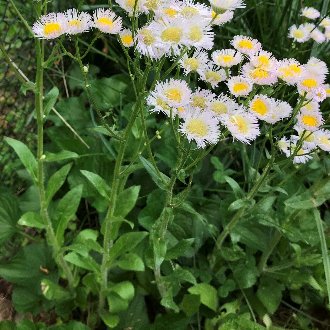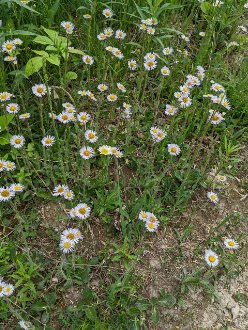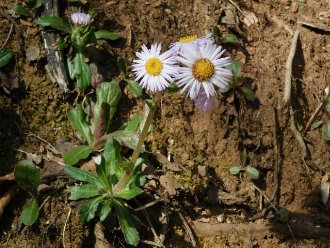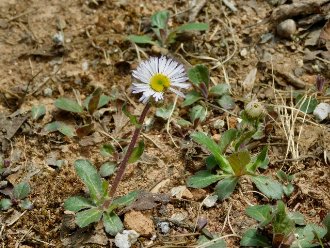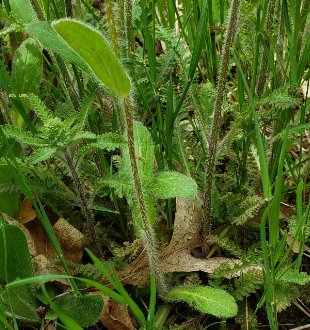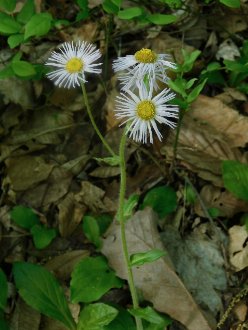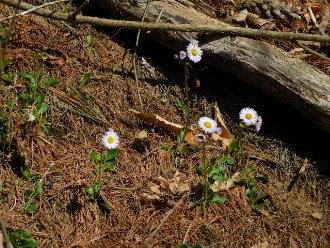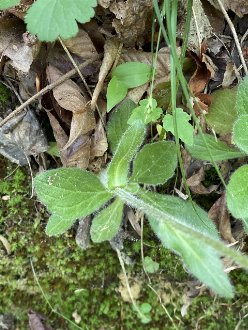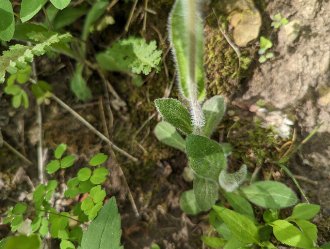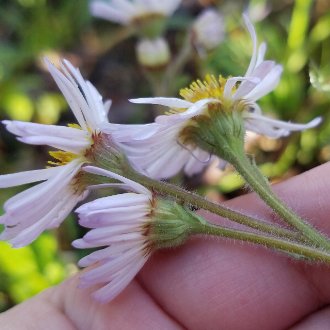Robin's Plantain (Erigeron pulchellus Michx.)
Also known as hairy plantain, blue spring daisy.
↑Summary
A perennial favoring slightly dry sites of low soil fertility in open woodlands.
↑Similar Plants
↑Habitat
Found in a variety of undisturbed to minimally disturbed open woodland habitats, including open rocky woodlands, partly-wooded bluffs, sand dunes, savannas, upper slopes of rocky streambanks, and woodland clearings. Usually limited to undisturbed sites where the open nature of the habitat persists long-term due to soil conditions.
Found in mesic to dry conditions in a variety of soil types, including clay-loam, rocky soils, and sand, but usually limited to sites where rocks, sand, or otherwise infertile soils limit the growth of competing ground-level vegetation. Surface level conditions on these sites may range from exposed soil, to soil covered with a thin carpet of moss, to rock outcroppings interspersed with pockets of soil, or to sparse cover from relatively thin herbaceous vegetation. This species is often more numerous on (but not restricted to) calcareous soils. It often prefers growing on slopes, especially where the slope is steep enough to limit accumulation of leaf litter.
This species is usually found in partial sun to light shade or areas with dappled sunlight under an open canopy of trees; it ranges farther into sun in the north of its range, where it is often found in savannas or wider clearings adjacent to forests, whereas in the south of its range it is more restricted to shady habitats with only small gaps in the forest canopy.
There is little overlap with other fleabanes in habitat tolerances. This species is less tolerant of disturbance, poor drainage, full sun, and competition from ground-level vegetation than other Erigeron species. It prefers drier conditions and poorer soil than E. philadelphicus and E. annuus, but moister than E. strigosus. It is much less tolerant of flooding and poor drainage than E. philadelphicus, and somewhat less so relative to E. annuus.
↑Life Cycle
Robin's plantain is a long-lived perennial that often reproduces primarily vegetatively.
Plants typically form vegetative colonies, connected by rhizomes or stolons. Especially in shady conditions, only a small portion of established plants produce flowering stalks, and plants may grow for multiple years before flowering. Flower production can be greater in higher-light conditions.
Plants bloom in mid-spring, sometimes extending into early summer especially in the north of its range when bloom times are later. Seeds are wind-dispersed, and flowering stalks die down rapidly after seeds mature. Basal leaves, which represent the bulk of the leaves, persist throughout the year, and are evergreen in milder climates.
We could not find documentation of this species lifespan in the wild. However it is much longer than other Erigeron species in its range, and, due to the stability of its habitats, vegetative colonies may persist for many years.
↑Faunal Associations
The foliage of this species is palatable to mammals, including deer, rabbits, and livestock; browsing is discouraged by mechanical adaptations including most leaves being tightly pressed against the ground, and densely-pubescent leaves on some plants. Herbivore pressure, which is stronger on this species due to the lack of competing vegetation in its preferred habitat, may explain why this species has more basally-inclined leaves and often has denser pubescence than other Erigeron species in its range.
The flowers attract a variety of small pollinators, including small bees, flies, and small butterflies and skippers. There are several moths whose larvae eat the flowers of fleabanes (Erigeron sp.) in general, although we have not verified which of them eat this species in particular. The aphid Aphis middletonii feeds on the roots of this and many other plants, mostly in the Aster family, and the gall-forming aphid Prociphilus erigeronensis also feeds on this genus.
The seeds are eaten by small rodents, including the white-footed mouse (Peromyscus leucopus), but are not among their most important food sources.
Although this species is often uncommon, it can be an important contributor to the food web in that it often occurs on micro-sites that would otherwise be devoid of vegetation, contrasting with other plants that, if removed, would be quickly replaced by other vegetation.
↑Uses
This species is occasionally cultivated in gardens, and is generally considered the most desireable of the four eastern Erigeron species. It is valued for its showy flowers, low maximum height, and more persistent nature relative to other fleabanes which can be short-lived and unpredictable but also more weedy. It is easy to grow in gardens so long as soil is not too rich. It tolerates light shade, drought, and a wide variety of adverse soil conditions, but in rich soils, it often struggles and gets quickly swallowed up by other vegetation.
Although it is not frequently used as such, this species can also be used for erosion control on slopes with exposed soil.
Common landscaping practices of mulching, watering, and soil enrichment often harm this plant more than help it, as they create conditions favoring other more aggressive plants. This species is best suited to a low-effort approach to gardening, and its use on suitable sites can reduce the need for more intensive management practices.
↑Related Plants
The exact relationships within the Erigeron genus are not well-known. This species is usually placed in a monotypic section of the genus, called "Pauciflori", and not considered closely related to other fleabanes. This section is somewhat closely related to annual fleabane (Erigeron annuus) and prairie fleabane (Erigeron strigosus), which are more closely-related to each other than they are to this plant. It is slightly less closely related to philadelphia fleabane (Erigeron philadelphicus). Although it is sometimes placed in a separate genus, some analyses have placed horseweed (Conyza canadensis) as being closer-related to this species than either is to E. philadelphicus.
↑Notes
The widely-used common name "Robin's Plantain" is misleading as this plant is not closely related to most plants referred to as "plantains", which are in the Plantago genus. This name likely references the growth habit of this plant, with a rosette of leaves pressed closely against the ground, superficially resembling plants the Plantago genus.
↑Links & External Resources
• Erigeron pulchellus (Robin's Plantain) | Illinois Wildflowers (About This Site)
• Erigeron pulchellus (robin's plantain) | USDA PLANTS Database (About This Site)
• Erigeron pulchellus | Go Botany (About This Site)
• Erigeron pulchellus (Robin's Plantain) | Missouri Botanical Garden Plant Finder (About This Site)
• Erigeron pulchellus | Biota of North America Project (BONAP) (About This Site)
• Erigeron pulchellus | NatureServe Explorer (About This Site)
• Erigeron pulchellus | Flora of North America (About This Site)
• Erigeron pulchellus | Missouri Plants (About This Site)
• Braun's Plantain | Maryland Biodiversity Project (About This Site)
• Robin's Plantain | Maryland Biodiversity Project (About This Site)
• Erigeron pulchellus Michx. | Plants of the World Online (POWO) (About This Site)
• Erigeron pulchellus (Robin's Plantain) | Minnesota Wildflowers (About This Site)
• Erigeron pulchellus Michx. var. pulchellus (Robin's Plantain) | Digital Atlas of the Virginia Flora (About This Site)




